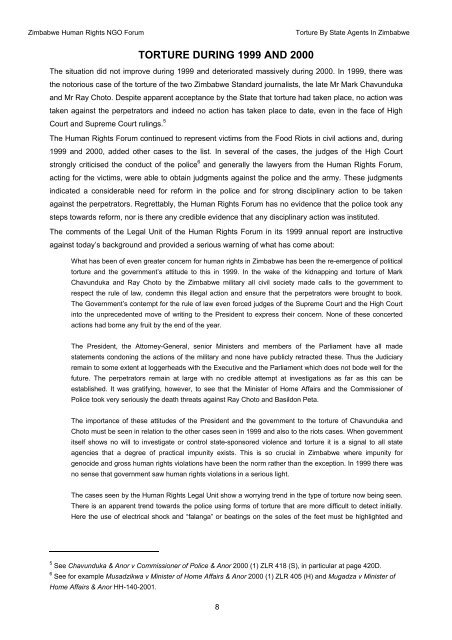Create successful ePaper yourself
Turn your PDF publications into a flip-book with our unique Google optimized e-Paper software.
Zimbabwe Human Rights NGO Forum<br />
Torture By State Agents In Zimbabwe<br />
TORTURE DURING 1999 AND 2000<br />
The situation did not improve during 1999 and deteriorated massively during 2000. In 1999, there was<br />
the notorious case of the torture of the two Zimbabwe Standard journalists, the late Mr Mark Chavunduka<br />
and Mr Ray Choto. Despite apparent acceptance by the State that torture had taken place, no action was<br />
taken against the perpetrators and indeed no action has taken place to date, even in the face of High<br />
Court and Supreme Court rulings. 5<br />
The Human Rights Forum continued to represent victims from the Food Riots in civil actions and, during<br />
1999 and 2000, added other cases to the list. In several of the cases, the judges of the High Court<br />
strongly criticised the conduct of the police 6 and generally the lawyers from the Human Rights Forum,<br />
acting for the victims, were able to obtain judgments against the police and the army. These judgments<br />
indicated a considerable need for reform in the police and for strong disciplinary action to be taken<br />
against the perpetrators. Regrettably, the Human Rights Forum has no evidence that the police took any<br />
steps towards reform, nor is there any credible evidence that any disciplinary action was instituted.<br />
The comments of the Legal Unit of the Human Rights Forum in its 1999 annual report are instructive<br />
against today’s background and provided a serious warning of what has come about:<br />
What has been of even greater concern for human rights in Zimbabwe has been the re-emergence of political<br />
torture and the government’s attitude to this in 1999. In the wake of the kidnapping and torture of Mark<br />
Chavunduka and Ray Choto by the Zimbabwe military all civil society made calls to the government to<br />
respect the rule of law, condemn this illegal action and ensure that the perpetrators were brought to book.<br />
The Government’s contempt for the rule of law even forced judges of the Supreme Court and the High Court<br />
into the unprecedented move of writing to the President to express their concern. None of these concerted<br />
actions had borne any fruit by the end of the year.<br />
The President, the Attorney-General, senior Ministers and members of the Parliament have all made<br />
statements condoning the actions of the military and none have publicly retracted these. Thus the Judiciary<br />
remain to some extent at loggerheads with the Executive and the Parliament which does not bode well for the<br />
future. The perpetrators remain at large with no credible attempt at investigations as far as this can be<br />
established. It was gratifying, however, to see that the Minister of Home Affairs and the Commissioner of<br />
Police took very seriously the death threats against Ray Choto and Basildon Peta.<br />
The importance of these attitudes of the President and the government to the torture of Chavunduka and<br />
Choto must be seen in relation to the other cases seen in 1999 and also to the riots cases. When government<br />
itself shows no will to investigate or control state-sponsored violence and torture it is a signal to all state<br />
agencies that a degree of practical impunity exists. This is so crucial in Zimbabwe where impunity for<br />
genocide and gross human rights violations have been the norm rather than the exception. In 1999 there was<br />
no sense that government saw human rights violations in a serious light.<br />
The cases seen by the Human Rights Legal Unit show a worrying trend in the type of torture now being seen.<br />
There is an apparent trend towards the police using forms of torture that are more difficult to detect initially.<br />
Here the use of electrical shock and “falanga” or beatings on the soles of the feet must be highlighted and<br />
5 See Chavunduka & Anor v Commissioner of Police & Anor 2000 (1) ZLR 418 (S), in particular at page 420D.<br />
6 See for example Musadzikwa v Minister of Home Affairs & Anor 2000 (1) ZLR 405 (H) and Mugadza v Minister of<br />
Home Affairs & Anor HH-140-2001.<br />
8
















